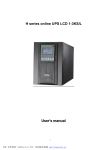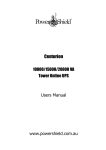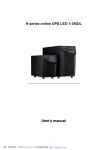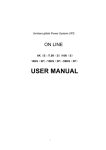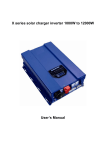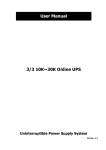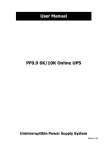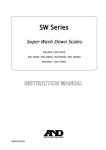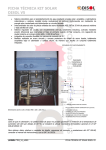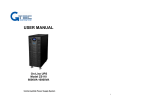Download H6K-20K LCD UPS user manual
Transcript
H series online UPS LCD 6/10KS(L), 10,15,20KL3/1 User ’s manual 1 PDF 文件使用 "pdfFactory Pro" 试用版本创建 www.fineprint.cn Thank you for purchasing our UPS, it is safe and liable, needs few maintenance. ☆ This manual includes instructions of safety installation and operation, they help your UPS to have the longest service life. This manual also accounts the UPS work principle and relative functions. ☆ Please obey the instructions and notes stated in this manual. Keep this manual in a safe place, consult it before operation. Safety rules ● Even if not connected to main power, high voltage may still presents at UPS outlets. ● If the external battery cord or power cord needs to be replaced, please contact our service station or franchiser for replacing to avoid fire disaster caused by insufficient capacity of such items. Don't dispose of battery or batteries group in a fire, otherwise, it can cause explosion and harm to people. Don't open the battery or do the battery damage, for the liquid spilled from battery is strongly poisonous and do harmful to body. ● Please avoid short-circuit between battery anode and cathode; otherwise, this will cause electric shock or fire. ● Don't dismantle the UPS cover, there is danger of electric shock. ● Don’t touch batteries. Batteries are not isolated with the input circuit, there is high voltage between the battery terminals and ground. ● Don’t connect with the electric equipment such as blower, heater, drilling machine etc. They may damage the UPS. Notice: There presents high voltage in UPS. If there is any abnormal problem present, please consult the service center and do not attempt to repair the equipment under any circumstances. The address of service center has been detailed on the warranty card. Note: POCASA reserves the right to make changes to product described in this manual at any time and without notice for reasons of improvement. 2 PDF 文件使用 "pdfFactory Pro" 试用版本创建 www.fineprint.cn Contents 1. Brief introduction-------------------------------------------------------------------------------------------------------------------4 1.1. Technology introduction----------------------------------------------------------------------------------------------------4 1.2. System and model description--------------------------------------------------------------------------------------------5 1.3. Description of commonly used symbols--------------------------------------------------------------------------------5 1.4. Appearance--------------------------------------------------------------------------------------------------------------------6 1.5. Product specification and performance---------------------------------------------------------------------------------8 2. Installation---------------------------------------------------------------------------------------------------------------------------9 2.1. Unpacking and inspection--------------------------------------------------------------------------------------------------9 2.2. Safety notes------------------------------------------------------------------------------------------------------------------10 2.3. The description of front panel and display lamp--------------------------------------------------------------------10 2.4. Input and output power chords and protective earth ground installation--------------------------------------12 2.5. Operating procedure for connecting the long backup time model UPS with the external battery----------------------------------------------------------------------------------------------------------------------------------14 2.6. Parallel operation-----------------------------------------------------------------------------------------------------------15 3. Operation and operating mode-----------------------------------------------------------------------------------------------17 3.1. Operation---------------------------------------------------------------------------------------------------------------------17 3.2. Operating mode-------------------------------------------------------------------------------------------------------------18 4. Notes for battery disposal and battery replacement---------------------------------------------------------------------19 5. Troubles shooting----------------------------------------------------------------------------------------------------------------23 Appendix: Display panel -----------------------------------------------------------------------------------------------------------26 Appendix 2: EMC grade standards----------------------------------------------------------------------------------------------27 3 PDF 文件使用 "pdfFactory Pro" 试用版本创建 www.fineprint.cn 1. Brief introduction 1.1. Technology introduction ● This UPS is a sophisticated piece of equipment with 16 bit Microprocessor and advanced software programming technology, high frequency SPWM is created to control the inverter of UPS. This simplifies the control circuit, enhances the stability of UPS, also enables the UPS to have enhanced real-time performance that makes UPS respond the variety of external environment rapidly and insure that the control circuit is compact and reliable. ● Digital control technology to avoid the temperature excursion of hardware specification ● Self-diagnoses before startup help UPS to find potential failure to avoid any losses ● Double conversion on-line topology, which makes the UPS a pure sine wave machine with constant frequency, constant voltage, low noise and no interruption with mains power fluctuation, it protect the user's equipments ideally all the time. ● No transfer time when main power fail or main power restore, meets the requirements of precision instruments. ● Standard bypass function When UPS meets a fault, it can transfer to bypass seamlessly and provide alarm. ● Advanced voltage compensation technology, makes the wide input voltage range, reducing the battery usage, enhancing the adaptive ability against the bad mains power variation. ● Advanced wide frequency input technology Wide input frequency range of UPS gives UPS a good compatibility with generator under field circumstances. ● The advanced PFC technology on the input of UPS, improves the input power factor close to unity, raises the power efficiency, removes the harmonic noise from UPS to utility, lowers UPS operational costs, it's really an environmental friendly protection power supply. ● Smart management function Under mains power blackout, UPS would transfer to battery mode to supply power to loads, when battery voltage is low, UPS would protect itself and shuts down automatically. When main power restores, UPS would be turned on automatically to supply power to loads. ● Cold start function When there is no input, UPS can be turned on with battery pack, to meet the user's emergency needs. The cold start function is quite strong. UPS can be cold started on full load situation. ● Fault operation prevention function Every button has delay function, only when you press and hold the button for a certain time, required 4 PDF 文件使用 "pdfFactory Pro" 试用版本创建 www.fineprint.cn operation can be activated. ● Smart management function Under mains power blackout, UPS would transfer to battery mode to supply power to loads, when battery voltage is low, UPS would protect itself and shuts down automatically. When main power restores, UPS would be turned on automatically. ● Via internal or external SNMP card, UPS can go on internet, you can monitor and manage the UPS status through all kinds of network management system. 1.2. System and model description H online series is an uninterruptible power supply incorporating double-conversion technology. It provides perfect protection specifically for computer equipment communication systems to computerized instruments. Its true online double-conversion design eliminates all mains power disturbances. A rectifier converts the alternating current from the utility power to direct current. This direct current charges the batteries and powers the inverter. On the basis of this DC voltage, the inverter generates a pure sinusoidal AC voltage, which is constantly powering the loads. Computers and peripherals are thus powered entirely by the UPS. In the event of power failure, the maintenance-free batteries power the inverter. This manual is applicable to the following models: 1) The H6KS is model with inbuilt battery, hereinafter called 6KS; 2) The H6KL is a long backup time model, which is able to connect with the external battery bank, hereinafter-called 6KL; 3) The H10KS is a standard model with inbuilt battery, hereinafter-called 10KS; 4) The H10KL a is a long backup time model, which is able to connect with the external battery bank, hereinafter-called 10KL; 5) The H10KL3/1 is a three-phase input and single-phase output long backup time model, which is able to connect with the external battery bank. Hereinafter called three-phase 10KL. 6) The H15KL3/1 is a three-phase input and single-phase output long backup time model, which is able to connect with the external battery bank. Hereinafter called three-phase 15KL. 7) The H20KL3/1 is a three-phase input and single-phase output long backup time model, which is able to connect with the external battery bank. Hereinafter called three-phase 20KL. 1.3. Description of commonly used symbols The following symbols will be used in this manual and may appear during the course of your practical 5 PDF 文件使用 "pdfFactory Pro" 试用版本创建 www.fineprint.cn applications. Therefore, all users should be familiar with them and understand their meanings. Notation and Explanation Notation Explanation Alert you to pay special attention Caution of high voltage ︱ Turn on the UPS Turn off the UPS Idle or shut down the UPS Alternating current source (AC) Direct current source (DC) Protective ground Alarm silence Overload indication Battery check Recyclable Do not dispose with ordinary trash 1.4. Appearance 6 PDF 文件使用 "pdfFactory Pro" 试用版本创建 www.fineprint.cn Front display panel Back view of 6KL Back view of 10KL/three phase 10KL 7 PDF 文件使用 "pdfFactory Pro" 试用版本创建 www.fineprint.cn Back view of three phase 15KL/three phase 20KL 1.5. Product specification and performance 1.5.1. General specification (standard models) Model H6KS H6KL H10KS H10KL Power rating 6KVA/4.2KW 6KVA/4.2KW 10KVA/7KW 10KVA/7KW Frequency(Hz) 50/60 50/60 50/60 50/60 Voltage (176-276)VAC (176-276)VAC (176-276)VAC (176-276)VAC Current 31A Max 31A Max 50A Max 50A Max Voltage 192/240VDC 192/240VDC 192/240VDC 192/240VDC Current 24A Max 24A Max 40A Max 40A Max Voltage 220VAC/230VAC 220VAC/230VAC 220VAC/230VAC 220VAC/230VAC Dimension(W×D×H)mm 260×570×717 260×570×717 260×570×717 260×570×717 Net weight(Kg) 75 35 80 38 Input Battery Output Model Three-phase 10KL Three-phase 15KL Three-phase 20KL Power rating 10KVA/7KW 15KVA/10.5KW 20KVA/14KW Frequency(Hz) 50/60 50/60 50/60 Voltage (304-478)VAC (304-478)VAC (304-478)VAC Current 50A Max 75A Max 100A Max Voltage 192/240VDC 192/240VDC 192/240VDC Current 40A Max 60A Max 80A Max Voltage 220VAC/230VAC 220VAC/230VAC 220VAC/230VAC Dimension(W×D×H)mm 260×570×717 260×570×717 260×570×717 Net weight(Kg) 39 52 52 Input Battery Output 1.5.2. Dimension & weight for UPS with galvanic isolation Model H6KS H6KL H10KS H10KL Power rating 6KVA/4.2KW 6KVA/4.2KW 10KVA/7KW 10KVA/7KW Dimension(W×D×H)mm 700×430*845 700×430*845 700×430*845 700×430*845 Gross weight (Kg) 85 44 95 46 Model Three-phase 10KL Three-phase 15KL Three-phase 20KL Power rating 10KVA/7KW 15KVA/10.5KW 20KVA/14KW Dimension(W×D×H)mm 700×430*845 700×430*845 700×430*845 Gross weight(Kg) 48 60 60 1.5.3. Electrical performance Input Model Frequency Voltage 50Hz 8 PDF 文件使用 "pdfFactory Pro" 试用版本创建 www.fineprint.cn 60Hz Power factor 6KS(L)/10KS(L) Three-phase 10KL/15KL/20KL Single-phase ±4Hz >0.98(full load) Three-phase ±4Hz >0.95(full load) Output Voltage Power Frequency regulation factor tolerance Distortion Synchronized ±1% 0.7 lag Current Overload capacity crest rating 105%-130% load transfers to ±4Hz in Line THD<2% bypass mode after 10 minutes mode (AC mode) full load >130% load transfers to 3:1 ±0.1% of normal (linear bypass mode after 1 second maximum frequency in load) and shutdown the output after battery mode 1 minute 1.5.4. Operating environment Temperature Humidity Altitude Storage temperature 0℃-40℃ 20%-90% <1000m -15℃-40℃ Note: if the UPS is installed or used in a place where the altitude is above than 1000m, the output power must be derated in use, please refer to the following: Altitude(M) 1000 1500 2000 2500 3000 3500 4000 4500 5000 Derating power 100% 95% 91% 86% 82% 78% 74% 70% 67% 2. Installation 2.1. Unpacking and inspection 1). Unpack the packaging and check the package contents. The shipping package contains: l A UPS l A user manual l A communication cable l A battery cable (for “L” models only) 2). Inspect the appearance of the UPS to see if there is any damage during transportation. Do not turn on the unit and notify the carrier and dealer immediately if there is any damage or lacking of some parts. 3). Check if the equipment is just what you wanted to purchase. You can affirm through inspecting the model number on back panel of the equipment. 2.2. Safety notes 1). Keep good air circulation around UPS and far away from water, flammable gas and corrosive. 9 PDF 文件使用 "pdfFactory Pro" 试用版本创建 www.fineprint.cn 2). Don't place UPS on the slope and there should keep good air circulation between in-vent on front panel bottom and fan out vent on back panel. 3). The environment temperature around UPS should keep in a range of 0℃~40℃. 4). There will be phenomena of condensing if the equipment is dismantled or installed under low temperature. The equipment can't be installed unless it is full dry at internal and external of the equipment, otherwise, there will be danger of electric. 5). The socket that supplies power to UPS should be placed near the UPS and easy. 2.3. The description of front panel and display lamp 10 PDF 文件使用 "pdfFactory Pro" 试用版本创建 www.fineprint.cn 11 PDF 文件使用 "pdfFactory Pro" 试用版本创建 www.fineprint.cn 2.4. Input and output power chords and protective earth ground installation 2.4.1. Notes for installation 1) The UPS must be installed in a location with good ventilation, far away from water, inflammable gas and corrosive agents. 2) Ensure the air vents on the front and rear of the UPS are not blocked. Allow at least 0.5M of space on each side. 3) Condensation to water drops may occur if the UPS is unpacked in a very low temperature environment. In this case it is necessary to wait until the UPS is fully dried inside out before proceeding installation and use. Otherwise there are hazards of electric shock. 2.4.2. Installation Installation and wiring must be performed in accordance with the local electric code and the following instructions by professional personnel. For safety, please cut off the mains power switch before installation. The battery breaker also needs to be cut off if it is a long backup time model (“L” model). 1) Open the terminal block cover located on the rear panel of the UPS, please refer to the appearance diagram. 2) For H6KS(L) UPS, it is recommended to select the UL 1015 10AWG(6mm2)wire or other insulated wire which complies with AWG standard for the UPS input and output wirings. The protective earth ground wire refers to the wire connection between toe equipment which consumes electric equipment and the ground wire. The wire diameter of protective earth ground wire should be at least as above mentioned for each model and green wire of green wire with yellow ribbon wire is used. 1) After having completed the installation, make sure the wiring is correct. 12 PDF 文件使用 "pdfFactory Pro" 试用版本创建 www.fineprint.cn 2) Please install the leak current protective breaker at the output power distribution panel of the UPS if necessary. 3) To connect the load with the UPS, please turn off all the loads first, then perform the connection and finally turn on the loads one by one. 4) No matter the UPS is connected to the utility power or not, the output of the UPS may have electricity, the parts inside the unit may still have hazardous voltage after turning off the UPS. To make the UPS have no output, power off the UPS, and then disconnect the utility power supply. 5) Suggest charging the batteries for 8 hours before use. After connection, turn the input breaker in the “ON” position, the UPS will charge the batteries automatically. You can also use the UPS immediately without charging the batteries first, but the backup time may be less than the standard value. 6) If it is necessary to connect the inductance load such as a monitor or a laser printer to the UPS, the start-up power should be used for calculating the capacity of the UPS, as its start-up power consumption is too big when it is started. Input and output terminal block wiring diagram of H6KS(L)/H10KS(L) 2 Important notes: if the UPS is used in single mode, JP1 and JP2 must be connected by 10AWG (6mm ); if the UPS is used in parallel mode, the jumper between JP1 and JP2 must be removed. 13 PDF 文件使用 "pdfFactory Pro" 试用版本创建 www.fineprint.cn Input and output terminal block wiring diagram of three-phase 10KL Important notes: if the UPS is used in single mode, JP1 and JP2 must be connected by 10AWG (6mm2); if the UPS is used in parallel mode, the Jumper between JP1 and JP2 must be removed. Input and output terminal block wiring diagram of three-phase 15KS/20KS 2 Important notes: if the UPS is used in single mode, JP1 and JP2 must be connected by 6AWG (25mm ); if the UPS is used in parallel mode, the Jumper between JP1 and JP2 must be removed. 2.5. Operating procedure for connecting the long backup time model UPS with the external battery 1). The nominal DC voltage of external battery pack is 240VDC. Each battery pack consists of 20 pieces of 12V maintenance free batteries in series. To achieve longer backup time, it is possible to connect multi-battery packs, but the principle of “same Voltage, same type” should be strictly followed. 2). The connector of the external battery cable is used to plug into the external battery socket of the UPS The other end of the external battery cable is made of three open wires with ring terminals to connect with 14 PDF 文件使用 "pdfFactory Pro" 试用版本创建 www.fineprint.cn the external battery pack(s). The procedure of installing battery bank should be complied with strictly. Otherwise you may encounter the hazardous of electric shock. A. A DC breaker must be connected between the battery pack and the UPS. The capacity of breaker must be not less than the data specified in the general specification. B. Set the battery pack breaker in “OFF” position and connect the 20 pieces of batteries in series. C. You must connect the external battery cable to the battery first, if you connect the cable to the UPS first, you may encounter the hazardous of electric shock. The positive pole of the battery is connected to the H10KL/three-phase H10KL in parallel with blue and brown wires; the negative pole of the battery is connected to the H10KL/three-phase H10KL in parallel with black and white wires; the green and yellow ribbon wire is connected to the ground of the battery cabinet. For three-phase 15KL/20KL, the connection of battery wire is the same as that of input and output wire, and a green or green and yellow ribbon wire UL1015 6AWG(25mm2) must be connected between the input protective earth terminal and the battery cabinet. 3). To complete the connection by plugging the connector of the external battery cable into the external battery socket of the UPS. Do not attempt to connect any loads to the UPS now. You should connect the input power wire to the right position first, and then set the breaker of the battery pack in the ON position. After that set the input breaker in the ON position, The UPS begins to charge the battery packs at the time. The external battery cable diagram for H6KL/H10KL (the cable may vary from different “L” models) 2.6. Parallel operation 2.6.1. Brief introduction of the redundancy N+X is currently the most reliable power supply structure. N represents the minimum UPS number that the total load needs; X represents the redundant UPS number the fault UPS number that the system can handle simultaneously. The bigger the X is, the higher reliability of the power system is. For occasions where reliability is highly depended on, N+X is the optimal mode. As long as the UPS is equipped with parallel cables, up to 3 UPS can be connected in parallel to realize output power sharing and power redundancy. 15 PDF 文件使用 "pdfFactory Pro" 试用版本创建 www.fineprint.cn 2.6.2. Parallel installation 1) Users need to a standard 25-pin communication cable, which should have 25 cores, corresponding stitches and shield, as the UPS parallel cable. The length of the parallel cable is appropriate to less than 3M. 2) Strictly follow the stand-alone wiring requirement to perform the Input wiring of each UPS. 3) Connect the output wires of each UPS to an output breaker panel. 4) Disconnect the Jumper on JP1 and JP2 of the terminal block first, and connect each output breaker to a main output breaker and then to the load. ※ The requirement of the output wiring is as follows: l When the distance between the UPSs in parallel and the breaker panel is less than 20 meters, the difference between the wires of input & output of the UPSs is required to be less than 20%. l When the distance between the UPSs in parallel and the breaker panel is greater than 20 meters, the difference between the wires of input & output of the UPS is required to be less than 10%. 2.6.3. Operation and maintenance 1) To perform the general operation, follow the stand-alone operating requirement; 2) Startup: the units transfer to INV mode simultaneously as they start up sequentially in utility power mode: Shutdown: the units shut down sequentially in INV mode. When the last one completes the shutdown action, each unit will shut down the inverter simultaneously and transfer to bypass mode. Parallel installation diagram It is easy to operate the equipment, with no previous training. You just need to read through this manual and operate according to the instructions in it. The meaning of the LED indicators, please refer to the appendix 1 “Display panel”. 16 PDF 文件使用 "pdfFactory Pro" 试用版本创建 www.fineprint.cn 3. Operation and operating mode 3.1 Operation 3.1.1. Operation on utility mode 1). Once utility is plugged in, the internal charger starts to charge batteries, at this point the yellow LED is on and LCD status figure shows block “LINE” and “BATTERY” and the output voltage is zero, which means UPS has no output. 2). Press and hold the ON/OFF button for more than 2 seconds to turn on the UPS, then it will turn on the internal inverter. 3). Once turned on, the UPS will perform a self-test function, when the green LED lights on, LCD status figure shows block “LINE” and “INV” and “BATTERY”, that means UPS is working in utility mode. 3.1.2. Start up UPS by DC when utility is disconnected 1). When utility is disconnected, press and hold the ON/OFF button for more than 2 seconds to cold start the UPS. 2). The cold start is the same operation as when UPS is started with the utility in, and LCD status figure shows block “BATTERY” and “INV”, which means UPS is working in battery mode. 3.1.3. Turn off UPS in utility mode 1). Press and hold the ON/OFF button for more than 2 seconds to turn off the UPS, then it will turn off the internal inverter. 2). When turning off the UPS, UPS will run a self-test function, green LED will be off and yellow LED will be on, LCD status figure shows block ”LINE” and “BATTERY”, which means UPS has no output but still charge the battery. 3.1.4. Turn off UPS in battery mode 1). Press and hold the ON/OFF button for more than 2 seconds to turn off the UPS. 2). When turning off the UPS, UPS will run a self-test function, UPS has no output once there is no display on front panel. 3.1.5. UPS self-test/mute test operation 1). When UPS is on utility mode, press and hold the FUNCTION button for 1second, the buzzer will sound once every 4 seconds, the LED lights light around at the same time as the UPS runs self-testing, and it will last for 10 seconds. 17 PDF 文件使用 "pdfFactory Pro" 试用版本创建 www.fineprint.cn 2). When UPS is on battery mode, the buzzer stops beeping if you press and hold the FUNCTION button for 1 second, and it will restart to beep if you press and hold the ON button for one more second. 3.2. Operating mode 3.2.1. Utility mode On utility mode, the indication and displays are as following figures: Figure 3-1: Utility mode Green LED is on, LCD status figure shows block "LINE" and "BATTERY" and "INV". 1). If the INPUT letters in the item section (the second row on LCD display) flashes, it indicates the line and neutral are incorrect. 2). If load capacity graph in the graphic section(the third row on LCD display) flashes, yellow LED is on and the buzzer beeps once half second, it reminds that UPS carries over 100% load and you should remove the unnecessary load until the displayed load is below 100%. 3). If battery capacity graph in the graphic section (the third row on LCD display) flashes, yellow LED is on, it reminds that UPS is disconnected with batteries or battery voltage is low, and you should firstly check whether the battery connection is okay, if yes, the batteries may be fault and need to be replaced. You can press the FUNCTION button for 1 second to do the manual self-test, for more details please refer to the Troubleshooting table. 3.2.2. Battery mode On battery mode, the indication and displays are as following figure: 18 PDF 文件使用 "pdfFactory Pro" 试用版本创建 www.fineprint.cn Figure 3-2: Battery mode Green LED is on, LCD status figure shows block “BATTERY” and “INV”. 1). On battery mode, the buzzer will beep once every 4 seconds to provide an audible alarm, press and hold the function button for more than 1 second, the buzzer will stop beeping, press and hold the FUNCTION button for one more second, the buzzer will beep again. 2). If battery capacity graph in the graphic section(the third row on LCD display) flashes, yellow LED is on, the buzzer beeps once every second, it means the battery voltage is discharged to minimum protection voltage, and reminds users that the battery capacity is diminished and should save all data and works and then switch off the equipments. 3). You can test UPS back up function by disconnecting the utility. 4). If the INPUT letters in the item section (the second row on LCD display) flashes, it means the input voltage or frequency is beyond the extension. 3.2.3. Fault mode The front panel indication and display is as following: 19 PDF 文件使用 "pdfFactory Pro" 试用版本创建 www.fineprint.cn Figure 3-3: Fault mode Red LED is on. The digital section indicates the fault code. For more details please refer to the abnormal process table. 3.2.4. Backup time for the standard model The backup time of the long backup time model is dependent on the external battery pack capacity and the load level as well as other factors. The backup time of standard model may vary from different models and load level, please refer to the following: 20 PDF 文件使用 "pdfFactory Pro" 试用版本创建 www.fineprint.cn Load capacity Load capacity 6KS(L) backup time curve 10KS(L) backup time curve 3.2.5. Communication port Intelligent slot This series is equipped with an intelligent slot for web power (optional accessory) or other optional card to achieve remote management of the UPS through internet/intranet. Please contact your local distributor for further information, RS232 Interface The following are the descriptions and pin assignment of RS232 DB-9 port: Baud rate: 2400bps Data bit: 8 bit Ending bit: 1 bit Parity bit: none DB-9 pin assignment: Pin number Function description I/O 3 Rx Input 2 Tx Output 5 Gnd Ground Optional AS400 interface 21 PDF 文件使用 "pdfFactory Pro" 试用版本创建 www.fineprint.cn RS232 interface This optional AS400 card provides dry contact closure signal “OPEN” or “CLOSE”. Following are the pin assignment and the descriptions of AS400 card: PIN1:UPS failure (normally open, active close) PIN2:Summary PIN3:Ground PIN4:Remote shutdown PIN5:Common PIN6:Bypass active (relay close) PIN7:Battery low PIN8:UPS On (relay close) PIN9:Utility Power failure (normally open, active close) AS400 Interface 3.2.6. Battery maintenance This series UPS only requires minimal maintenance. The battery used for standard models are value regulated sealed lead-acid maintenance free battery. These models require minimal repairs. The only requirement is to charge the UPS regularly in order to maximize the expected life of the battery. When being connected to the utility power, whether the UPS is turned on or not, the UPS keeps charging the batteries and also offers the protective function of overcharging and over-discharging. l The UPS should be charged once every 4 to 6 months if it has not been used for a long tine. l In the regions of hot climates, the battery should be charged and discharged every 2 months. The standard charging time should be at least 12 hours. l Under normal conditions, the battery life lasts 3 to 5 years. In case if the battery is found not in good condition, earlier replacement should be made. Battery replacement should be performed by qualified personnel. l Replace batteries with the same number and same type of batteries. l Do not replace the battery individually. All the batteries should be replaced at the same time following toe instructions of the battery supplier. Normally, the batteries should be charged and discharged once every 4 to 6 months. Charging should begin after the UPS shuts down automatically in the course of discharging, the standard charging time for the standard UPS should be at least 12 hours. 22 PDF 文件使用 "pdfFactory Pro" 试用版本创建 www.fineprint.cn 4. Notes for battery disposal and battery replacement ● The battery of standard unit is of valve regulated, maintenance free. It can attain expectant life only by keeping frequent charging. Regardless of UPS on or off when UPS connects to utility power, the battery is charged all the time and UPS offers protection for over-charge and over-discharge. ● Normally the battery life is three to five years and the battery must be replaced ahead of time once there presents any abnormal status. The battery replacement must only be performed by qualified personnel. ● It is inadvisable to replace a single battery. Operator should obey the instruction of battery distributor when replacing all batteries. ● The batteries should be charged and discharged once every four to six months. After UPS discharged to off, the batteries should be recharged. The charge time of standard unit must be more than 12 hours. ● The battery must be charged and discharged once every two months in high-temperature area. The charge time of standard units must be more than twelve hours. 1. If it is necessary to replace any connection cables, please purchase the original materials from the authorized distributors or service centers, so as to avoid overheat or spark resulting in fire due to insufficient capacity. 2. Do not dispose of batteries or battery packs in a fire, they may explode. 3. Do not open or mutilate batteries, released electrolyte is highly poisonous and harmful to the skin and eyes. 4. Do not short the positive and negative of the battery electrode, otherwise, it may result in electric shock or fire. 5. Make sure that there is no voltage before touching the batteries. The battery circuit is not isolated from the input potential circuit. There may be hazardous voltage between the battery terminals and ground. 6. Even though the input breaker is disconnected, the components inside the UPS are still connected with the batteries, and there are potential hazardous voltages. Therefore, before any maintenance and repairs work is carried out, switch off the breaker of the battery pack or disconnect the jumper wire of connecting between the batteries. 23 PDF 文件使用 "pdfFactory Pro" 试用版本创建 www.fineprint.cn 7. Batteries contain hazardous voltage and current. Battery maintenance such as the battery replacement must be carried out by qualified personnel who are knowledgeable about batteries. No other persons should handle the batteries. 5. Troubles shooting The following messages are the messages that users would find on UPS when it meets some problem, with the use of such messages, users can know where the problems are and how to deal with such problems. ◆ Fault indicator on, indicates UPS has detected some fault. Buzzer beeps, indicate UPS need to be paid attention to. ◆ Several fault indicators and status indicators on, are to help the user to diagnose fault. 24 PDF 文件使用 "pdfFactory Pro" 试用版本创建 www.fineprint.cn When you contact the service center, please provide the following information: ● Model No. and the serial No. of the UPS; ● The date when the problem arose; 25 PDF 文件使用 "pdfFactory Pro" 试用版本创建 www.fineprint.cn ● Complete description of the problem, including the LED display, alarm warning, and power condition and load capacity. If your UPS is a long backup time model, you may also provide the battery information. 26 PDF 文件使用 "pdfFactory Pro" 试用版本创建 www.fineprint.cn Appendix 1: Display panel The description of front panel and display lamp Description of the front panel LCD panel section: l The first line is the numeric section, and is consisted of two small numeric sections and the related unit section on the right side. It is used to display the numerical value of the certain item on the second line. l The second line is the section of the items which include input, battery, output, load and temperature, etc. l The third line is the figure section which is consisted with two parts , the parts on the left shows the working status of UPS, the parts on the right shows the load capacity (on the top) and battery capacity (on the bottom) by schematic figure. LED panel section ● Power ON/OFF: to turn on the UPS simply by pressing the “ON” button on the front panel continuously for 1 second. Press the “OFF” button on the front panel continuously for 1 second to turn off the UPS. ● Bypass LED (orange LED): whenever the bypass LED is turned on, it shows that the loading current is supplied directly from the utility power. ● Utility power LED (green LED): whenever the utility power LED is turned on, it shows that the utility power is normal. ● Inv LED (green LED): whenever the INV LED is turned on, it shows that the loading current is supplied from utility power or battery via the inverter. ● Battery LED (orange LED): whenever the battery LED is turned on, it shows that the loading current is supplied from battery via the inverter. ● Fault LED (red LED): whenever the fault LED is turned on, it shows that the UPS is in abnormal 27 PDF 文件使用 "pdfFactory Pro" 试用版本创建 www.fineprint.cn condition. ● #2-#6 LEDs (the #2 LED is orange and the #3-#6 LEDs are green): These LEDs indicate the percentage of the load capacity in utility power mode or battery capacity level in battery mode. Description of the buttons Buttons’ function: l ON/OFF button Press and hold for some time to turn on/off the UPS. l FUNCTION button Press and hold for some time on utility mode: UPS runs a self-test function. Press and hold for some time on battery mode: mute function. l INQUIRING button Press for short time: indicate the items of the second row item section orderly. Press and hold for some time: circularly and orderly display the items from INPUT, BATTERY, OUTPUT, LOAD & TEMPERATURE every 2 seconds. When you press and hold the button for some time again, it will turn to static output status. Appendix 2: EMC grade standards H series UPS are manufactured according to the following: EMC international grade standard: 28 PDF 文件使用 "pdfFactory Pro" 试用版本创建 www.fineprint.cn





























